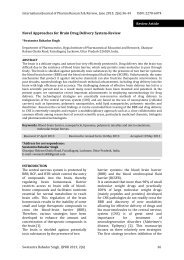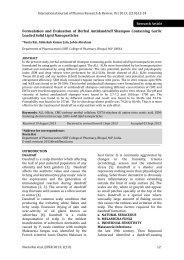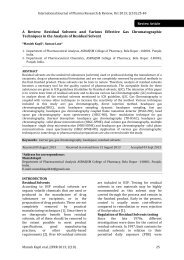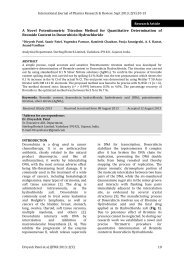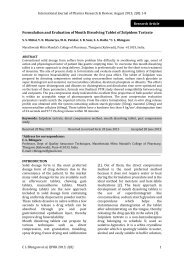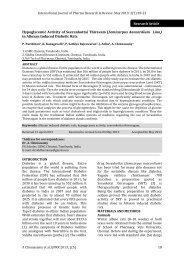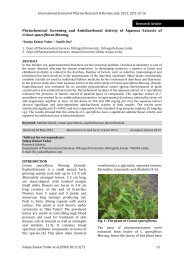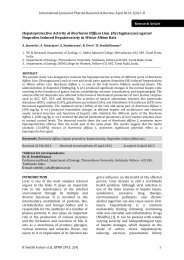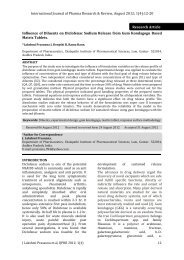<strong>International</strong> <strong>Journal</strong> <strong>of</strong> <strong>Pharma</strong> <strong>Research</strong> & <strong>Review</strong>, <strong>May</strong> <strong>2013</strong>; 2(5):13-17book Yugi vaithiya sinthamani (7).Nociception is the neural processes <strong>of</strong>encoding and processing <strong>of</strong> noxious stimuli(8). It is the afferent activity produced inthe peripheral and central nervous systemby the stimuli that have potential to damagethe tissues (9). To prove scientifically, theefficacy <strong>of</strong> the drug karunkali ver (Acaciaroot) in Diabetic neuropathy central andperipheral acting analgesic activity has beencarried out.MATERIALS AND METHODSDrugs and chemicalsAcetic acid, and CMC, all from Sigma-AldrichChemicals were the chemicals used. Thestandard drugs aspirin and Pentazocin wasprocured from the local market. All theother chemicals and drugs used were <strong>of</strong>analytical grade.Fig. 1: Root <strong>of</strong> KarunkaliStock solution preparationAs recommended in SOP, 100 grams finepowder <strong>of</strong> dried root <strong>of</strong> karungali ver(Acacia catechu) is added in 200 ml <strong>of</strong>water. Then it was boiled continuously tillthe total volume is concise to 1/4 th as adecoction. The filtered supernatant fluidwas employed for the preclinical study.AnimalsAlbino mice (22–28 g) either sex wereobtained from the animal house <strong>of</strong> animalhousing facility <strong>of</strong> department <strong>of</strong>pharmacology, Vels University, Chennai.Animals were maintained at standardlaboratory conditions and fed with standardfeeding pellets (Sai durga foods, Bangalore).Prior to treatment, the animals were fastedfor 10 and 12 h respectively (10). However,water was made available ad libitum.(ApprovalnumberXIII/VELS/PCOL/05/2000/CPCSEA/IAEC/08.08.2012)Experimental MethodsAcute toxicity safety StudyAcute oral toxicity test for the KarunkaliverKudineer was carried out as per OECDGuidelines 425 (11). As with othersequential test designs, care was taken toensure that animals are available in theappropriate size and age range for theFig. 2: Prepared Drug <strong>of</strong> Karunkali VerKudineerentire study. The test substance isadministered in a single dose by gavageusing a stomach tube or a suitableintubation cannula. The fasted body weight<strong>of</strong> each animal is determined and the dose iscalculated according to the body weight.After the substance has been administered,food was withheld for a further 2 hours inmice. The animals were observedcontinuously for the first 4 h and then eachhour for the next 24 h and at 6 hourlyintervals for the following 48 h afteradministering <strong>of</strong> the test drug, to observeany death or changes in general behaviorand other physiological activities. Singleanimals are dosed in sequence usually at 48h intervals.However, the time interval between dosingis determined by the onset, duration, andseverity <strong>of</strong> toxic signs. Treatment <strong>of</strong> ananimal at the next dose was delayed untilone is confident <strong>of</strong> survival <strong>of</strong> thepreviously dosed animal. General behavior,respiratory pattern, cardiovascular signs,motor activities, reflexes, change in skin andfur, mortality and the body weight changeswere monitored daily. The time <strong>of</strong> onset,intensity, and duration <strong>of</strong> these signs, if any,was recorded.S Umera et.al, IJPRR <strong>2013</strong>; 2(5) 14
<strong>International</strong> <strong>Journal</strong> <strong>of</strong> <strong>Pharma</strong> <strong>Research</strong> & <strong>Review</strong>, <strong>May</strong> <strong>2013</strong>; 2(5):13-17Evaluation <strong>of</strong> analgesic activity by Eddy’sHotplate methodThe hot-plate test method was employed toassess the analgesic activity. Thetemperature <strong>of</strong> the cylinder was set at55±0.5 0 C. The experimental mice weredivided into four groups. Each mouse actedas its own control. Prior to treatment, thereaction time <strong>of</strong> each mouse (licking <strong>of</strong> theforepaws or jumping response) was done at0 and 10min interval. The average <strong>of</strong> thetwo readings was obtained as the initialreaction time. The reaction time followingthe administration <strong>of</strong> the KarunkaliverKudineer (1, 2, 4ml/kg, p.o.), Pentazocin(5mg/kg) and Saline (p.o.), was measuredat 30, 60, 90 and 120 minutes after alatency period <strong>of</strong> 30 mins. The Percentageanalgesic activity was calculated (12).Anti nociceptive testingThe anti nociceptive property <strong>of</strong>Karunkaliver Kudineer was tested using themodel <strong>of</strong> writhing response in mice. Swissalbino mice <strong>of</strong> either sexes weighing 20-30g were used. The writhing syndrome waselicited by an intra peritoneal injection <strong>of</strong>0.7% acetic acid at the dose <strong>of</strong> 0.1ml/10 gbody weight. For the test group <strong>of</strong> animalsKarunkaliver Kudineer at the dose level <strong>of</strong>1, 2, 4ml/kg, per oral and for control groupvehicle saline and Aspirin 100mg/kg wasorally administered into the mice 30 minbefore acetic acid and the number <strong>of</strong>writhes was noted for 15 min beginning 5min after acetic acid injection (13).Statistical dataData were presented as mean ± S.E.M.Statistical differences between control andtreated groups were tested by one wayANOVA followed by dunnet’s test.RESULTS AND DISCUSSIONKarunkaliver Kudineer was found safe at alltest doses (5, 10 and 20ml/kg p.0.). During24h assessment time, test animals werefound normal. Hence the therapeutic dosewas fixed as 2 and 4ml/kg according to thesafety guidelines. Acetic acid, which is usedas an inducer for writhing syndrome, causesalgesia by liberation <strong>of</strong> endogenoussubstances, which then excite the painnerve endings. It was found that Aspirincaused an effective or significant inhibitionon the writhing response induced by aceticacid.Table 1: Dose finding experiment and its behavioral Signs <strong>of</strong> ToxicityDoseNo ml/kg1 2 3 4 5 6 7 8 9 10 11 12 13 14 15 16 17 18 19 201. 5 + - - + - + - - - - - - - - - - - - - -2. 10+ - - + - + - - - - - - - - - - - - - -3. 20 + - - + - + - - - - - - - - - - - - - -1. Alertness 2. Aggressiveness 3. Pile erection 4. Grooming 5. Gripping 6. Touch Response 7.Decreased Motor Activity 8. Tremors 9. Convulsions 10. Muscle Spasm 11. Catatonia 12. Musclerelaxant 13. Hypnosis 14. Analgesia 15.Lacrimation 16. Exophthalmia 17. Diarrhea 18.Writhing 19. Respiration 20. MortalityDoses <strong>of</strong> 1, 2 and 4ml/kg <strong>of</strong> theKarunkaliver Kudineer were evaluated toverify the peripheral analgesic effect. Butthe results for the animal group treatedwith Karunkaliver Kudineer did not differsignificantly from negative control. Hence, itis assumed that Karunkaliver Kudineer hasno statistically significant peripheralanalgesic effect. Therefore, despite <strong>of</strong> themild effect observed for the doses <strong>of</strong> 4ml/kgfor this test, it was not statisticallysignificant to that <strong>of</strong> control. Similarly, theresult <strong>of</strong> the analgesic activity evaluatedusing hot plate method revealed that thereaction time for mice was significantlyincreased in a dose dependent manner after90minutes <strong>of</strong> oral administration. TheKarunkaliver Kudineer at the both2&4ml/kg doses remarkably protected themice against thermally induced noxiousstimuli, which was evidenced from the hotplate test. Hot plate test was assayed tocharacterize the central analgesic activity.The results showed that the pain relief wasachieved in a dose dependent manner, atboth test doses (1, 2 and 4 ml/kg).S Umera et.al, IJPRR <strong>2013</strong>; 2(5) 15




